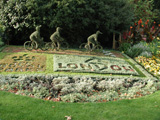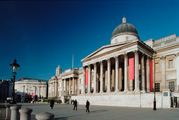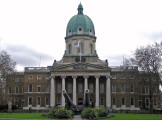Bohemian Chic in London and Paris
Originally published in April 2015 in American in Britain Magazine
Soho was a seedy area back in London’s swinging sixties. Bohemian artists, writers and poets frequented the coffee bars and jazz joints. Thea Porter arrived in London from Beirut in 1966 and opened her boutique on Greek Street in Soho just as exotic non-Western and hippie clothing was becoming fashionable. Meanwhile In Paris, Sonia Delaunay was already an established artist enjoying success as a painter, fashion and textile designer.
Bohemian Chic in London and Paris
By Abby Cronin Thea Porter in London Imagine yourself back in London’s swinging sixties when Soho was a seedy area where bohemian artists, writers and poets frequented coffee bars and jazz joints. Just as exotic non-Western and hippie clothing were becoming fashionable, Thea Porter arrived in London from Beirut. Soho was exactly the right place for her to open a small shop on Greek Street. The summer of 1966 was perfect timing and her shop resembled a bazaar similar to the ones she had known as a child growing up in the Middle East. As an experienced interior designer, Thea furnished the shop with rugs, embroidered textiles, traditional kaftans and garments mainly imported from Syria, Persia and India; they covered virtually every surface. The shop was an immediate success. Her kaftans sold so quickly that her imports couldn’t keep up with demand, so she began to design and produce them herself. She wrote in her archival memoir: “my shop almost immediately attracted rich hippies, actors, musicians and their women, who rummaging excitedly through my fabrics, demanded that I make clothes for them”. Indeed, that is exactly what she did Thea Porter’s background was ideally suited to the bohemian atmosphere of Soho in the 1970s. Born in Jerusalem in 1927, she had grown up in Damascus and her earliest memories were wandering around the covered bazaars with her mother. Her life-long passion for Eastern textiles, trimmings, gold, buttons and lace stemmed from those early years. Even the smells of perfumes and oils remained with her. In 1949 the family moved to Beirut where in 1953, Thea met and married a British diplomat and found herself in the swirl of Embassy life. Their daughter, Venetia, was born. Restless, she split from her husband and finally settled in London in 1964. Why has it taken so long for Thea Porter’s ‘Bohemian Chic’ to be remembered? The short answer is that curator Laura McLows Helms, a fashion historian, initiated and researched Porter’s archive for four years. She has her own collection of Porter’s clothes and conducted numerous interviews with Thea’s friends and daughter before the exhibition could be mounted. Now, at last, Thea Porter 70s Bohemian Chic can be seen at the Fashion and Textile Museum in Bermondsey until May 3rd 2015. The exhibition is a tour de force – a comprehensive display of Thea Porter’s life and times. As visitors stroll along the entrance corridor they can study displays of family photos and letters which provide an introduction to Porter’s personal background. Several of Thea’s paintings emphasize vivid colours which influenced her designs for Middle Eastern clothing. But there is much more than Porter’s fashions on display. McLows Helms explained how she was able to find and assemble Thea’s authentic dining room just as it appeared in her flat. “Thea was known for her parties at her amazing flat on Bolton Street. She had been an interior designer before she was a fashion designer. Her mirror dining room was something we were able to recreate using her mirrors, cutlery and original furniture. We reupholstered her original chairs and reprinted the peacock fabric for the chairs – and included her books and records.” The display features models wearing Thea’s clothes sitting as though they were guests at a dinner party. Thea’s journeys took her from Beirut through to London, Paris, New York and Los Angeles. Each location is represented in the exhibition. Several settings feature fashions worn by Thea’s high-profile clientele such as the Beatles, Pink Floyd and Barry Humphries, who bought flowing garments from Thea to wear as Dame Edna Everage. Elizabeth Taylor and Barbra Streisand wore her clothes in their films and multiples of Thea’s designs were bought by Faye Dunaway and Henry Fonda’s wife. The producer of Hair, the hit musical, ordered a new jacket from Thea whenever a new production opened anywhere in the world. Henri Bendel, one of the chicest stores in New York, briefly opened a Thea Porter boutique department in 1971. Vogue, Harper’s Bazaar and Women’s Wear Daily featured fashion photography of her clothes. In Paris, Porter’s shop was short-lived with clothes designed for Parisian customers – Parisian with an exotic edge. The fabrics were combinations of blacks in velvets, silks, chiffons and lace – stunning and graceful. Thea’s rich legacy is perhaps best summed up by noting her seven key pieces. The kaftan was the first and basic design. From that basic shape she adapted the kaftan and extended her range using intricate styles echoing historical forms to create an exotic street and party chic. Famous designers such as Fortuny, Poiret and Leon Bakst’s costumes for the Ballets Russes inspired her. But her seven key garments on display in the exhibition include the Abaya, the Gipsy dress, the Faye dress, a brocade dress with sheer panels, the wrap-over dress, the Chasara jacket and a Sirwal-like skirt. Each one has a distinct modernity. She felt that “whatever else clothes may be about, I believe they must add to the enjoyment of life”. Today Thea Porter’s ‘bohemian chic’ is back in vogue. It is sought after by celebrities who buy her clothes for high prices at auction and her designs can be seen in current ready-to-wear collections which feature a diversity of Porter’s iconic elements. Sonia Delaunay in Paris If your interest in textile design has been stimulated by reading about Thea Porter’s bohemian 1970s fashions, be sure to head over to Tate Modern where the first UK retrospective exhibition of Sonia Delaunay’s work is on until August 9th 2015. To appreciate Delaunay’s work, imagine yourself back in Paris in the early years of the 20th century. Delaunay (1885-1979), a Russian émigrée to Paris, married the French artist Robert Delaunay after a brief marriage to William Uhde, an unconventional German art collector. Together Sonia and Robert moved in avant-garde circles that included artists, writers, musicians, poets and intellectuals. Her art and practice reflects elements of Russian constructivism and designs from the late Bauhaus school. Both Sonia and Robert shared a strong visual aesthetic for multiple combinations of colour and abstraction. The artistic schools of Fauvism, Dada, Surrealism, expressionism and abstraction developed in bohemian circles in early 20th century Paris. And it was in this period that Sonia Delaunay’s creativity and practice flourished. Moving away from her early concern with figurative painting she went on to experiment with colour expressed in terms of vivid geometric images both on and off the canvas. In 1918 a unique opportunity came when she accepted Diaghilev’s invitation to design costumes for the Ballets Russes. The costumes were modern, daring, eccentric and featured her geometric designs. Her decorative textile patterns for fashion were most unconventional. She developed a concept of ‘simultanism’ which involved putting movement into clothing in order to suggest the transformation of a woman’s body. Illustrated here is an example of ‘simultanism‘– Simultaneous Dresses (The three women), 1925. When she opened a fashion house in Paris in 1923, she attracted clientele from stage, screen and high society; Nancy Cunard and Gloria Swanson were delighted to be seen in Sonia Delaunay coats. The Coat made for Gloria Swanson 1923-24embodies Delaunay’sability to merge colour, texture and design and perhaps best expresses Delaunay’s creativity. Throughout the twenties her designs were manufactured in Lyon where multiples of her fabrics were produced and used for clothing and scarves. Several will be on display in the Tate retrospective. Delaunay was fascinated by the rapidly modernising urban environment in Paris. The Eiffel Tower was symbolic and influenced her composition Electric Prisms in 1913. She expressed her fascination with advances in technology in a composition entitled: Propeller Air exhibited in the Palais de l’Air in the 1937 Paris exposition. All aspects of modern urban life served as stimuli and Sonia responded to these challenges continuously. Even though a few decades separated them, both women were genuine originals. These were years when women rarely managed to create viable enterprises yet both Thea Porter and Sonia Delaunay were successful pioneering textile artists and fashion designers. Their textile designs, costumes, interiors and paintings deserve to be seen again so a 21st-century public can appreciate them. They represent more than a little bit of fashion and art history. __________________________________________________________________________________________________________________________ Exhibition Dates & Location Thea Porter 70s Bohemian Chic – 6 February – 3 May 2015 Fashion and Textile Museum, 83 Bermondsey Street, London SE1 3XF www.ftmlondon.org Images Courtesy: Fashion and Textile Museum Thea Porter: Bohemian Chic by Laura McLaws Helms &Venetia Porter V&A Publications 2015 Sonia Delaunay – 15 April-9 August 2015 Tate Modern, The Eyal Ofer Galleries, Level 3 Bankside, London SE1 9TG tate.org.uk Images courtesy Tate Modern ***************************************************************************************** Get in touch. Contact: Abby Cronin Email: artsjournalist@abbycronin.co.uk Website: www.abbycronin.co.uk




